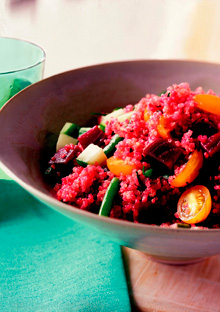Carb-o-licious! Delicious Whole Grains

Photo: Gentl & Hyers
Surrender the white—and go for the gold, the tan, the honeyed brown, the deep-dark chestnut of whole grain carbs.
Over the past decade, carbohydrates have been bullied, buffeted, scorned, insulted, and occasionally even expelled from our daily diets. Enough already! Carbs aren't evil—they're just a plant's way of storing energy. But the kind of carb you put in your mouth determines whether that plant power becomes fuel or fat in your body. Fortunately, we now have the wisdom to know the difference between "good" and "bad" carbs.Recipes: 7 carbolicious dishes
All vegetables, fruits, seeds, nuts, and grains contain carbohydrates (the word means simply "carbon plus water"), which take many forms, including sugars, starch, and cellulose or fiber. But the carbs that make dieters shudder are the pure starches found at the heart of grains such as wheat, rye, corn, rice, and barley. It's during the refining process that the trouble occurs ("refined" may be an excellent description for a Danish princess, but if you see it on a food label, run). The humble little grains are husked, chopped, pulverized, polished, and seared beyond recognition, the result being that they become nutritionally denuded, ransacked of B vitamins, fiber, and protein. You're left with a plateful of "empty" calories, which is nothing other than an existential way of saying "bad energy." After downing a helping of white rice or elbow macaroni, your blood sugar will skyrocket, then plummet, leaving you feeling weirdly tingly, wiped out, and desperately in need of...another heaping bowl of demon carbs. Along the way, your health and waistline are almost guaranteed to suffer.
Which is where unrefined, or good, carbs come in. Because of their high protein and fiber content, whole grain pastas, breads, pilafs, and cereals metabolize in your body evenly, in slow beats. You feel fuller longer, which means no more aerial blood sugar spikes that can make you as manic as a Snickers-fueled toddler. Better yet is the flavor: rich, nutty, complex, lightly crunchy.
Cup for cup, whole grain foods are heavier than their refined counterparts, which is why wholesome treats can sometimes be unbearably leaden. But there's no need to sacrifice pleasure for health: When baking, replace half the white flour with whole wheat, corn, rye, or oat. You'll retain the light and airy quality of your breads and cakes while boosting their value to your body.
"Heck," you might think, "if I'm going to start eating wheat germ, I might as well slap an I BRAKE FOR WOOD ELVES bumper sticker on my car and become a basket weaver." But whole grain doesn't mean hippie-dippy. From cornmeal-crust pizza to buckwheat crepes with raspberry jam, it just means nourishing, substantial, and over-the-top delectable. The right carbs will start making you feel better the moment they pass your lips. Never, in fact, has it tasted so wonderfully wicked to be this good.



